Impairment of Assets at Myer Holdings
VerifiedAdded on 2020/02/24
|7
|1642
|55
AI Summary
This assignment delves into the impairment of assets at Myer Holdings Ltd., focusing on their adherence to AASB 136 guidelines. It examines how the company determines recoverable amounts, conducts impairment tests, and handles potential reversals. The analysis highlights the flexibility afforded to management in carrying out these procedures while ensuring compliance with accounting standards.
Contribute Materials
Your contribution can guide someone’s learning journey. Share your
documents today.
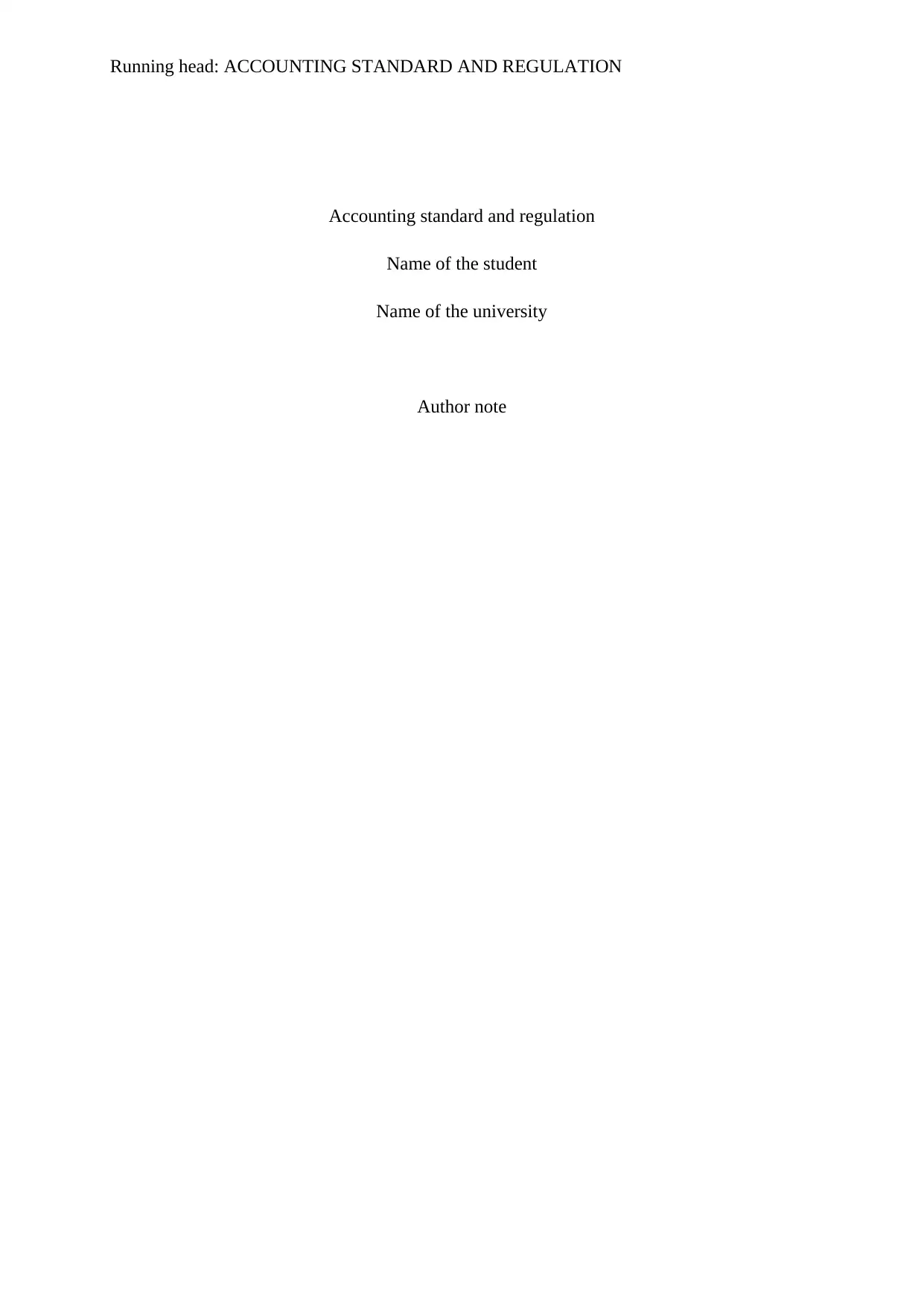
Running head: ACCOUNTING STANDARD AND REGULATION
Accounting standard and regulation
Name of the student
Name of the university
Author note
Accounting standard and regulation
Name of the student
Name of the university
Author note
Secure Best Marks with AI Grader
Need help grading? Try our AI Grader for instant feedback on your assignments.
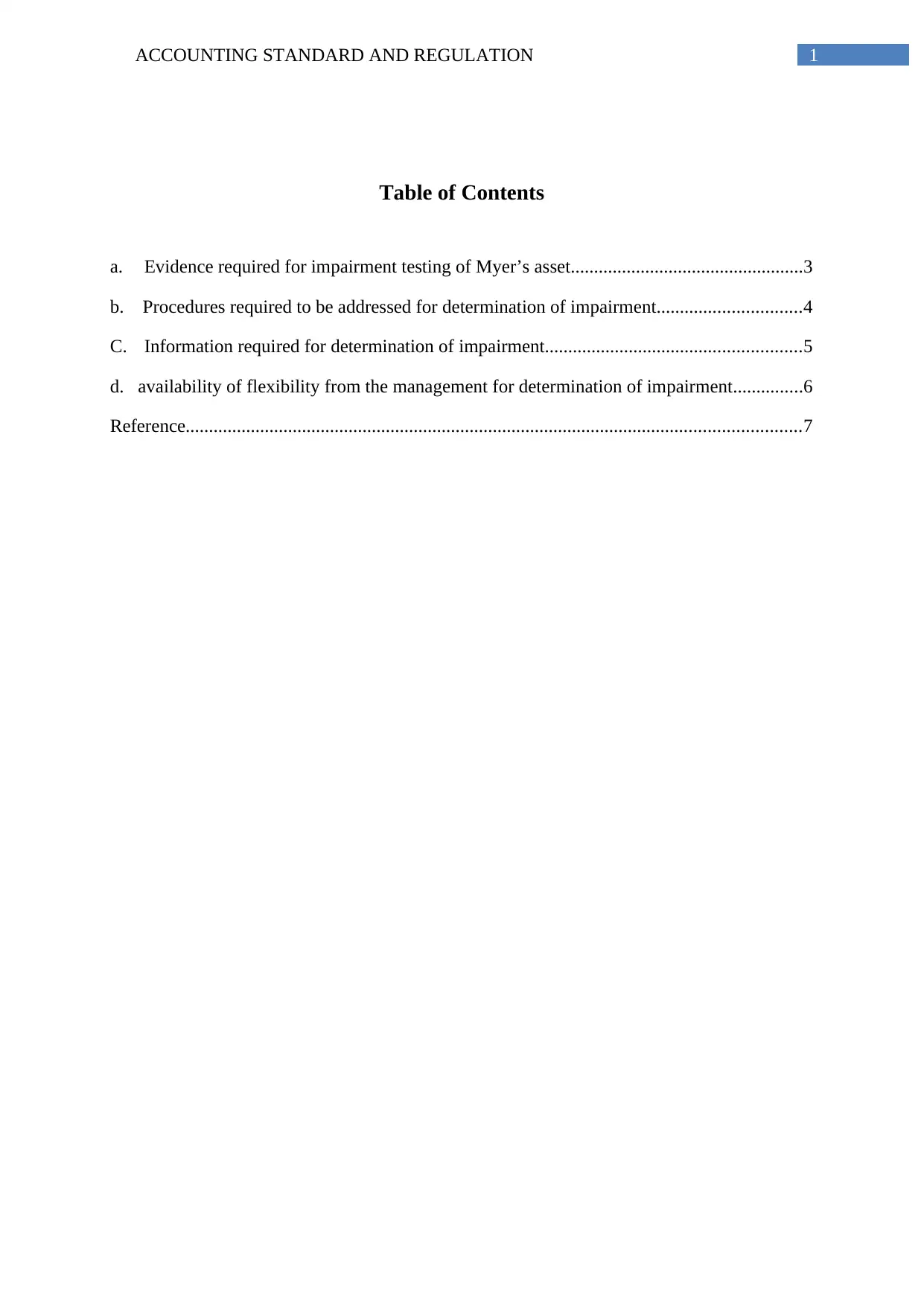
1ACCOUNTING STANDARD AND REGULATION
Table of Contents
a. Evidence required for impairment testing of Myer’s asset..................................................3
b. Procedures required to be addressed for determination of impairment...............................4
C. Information required for determination of impairment.......................................................5
d. availability of flexibility from the management for determination of impairment...............6
Reference....................................................................................................................................7
Table of Contents
a. Evidence required for impairment testing of Myer’s asset..................................................3
b. Procedures required to be addressed for determination of impairment...............................4
C. Information required for determination of impairment.......................................................5
d. availability of flexibility from the management for determination of impairment...............6
Reference....................................................................................................................................7
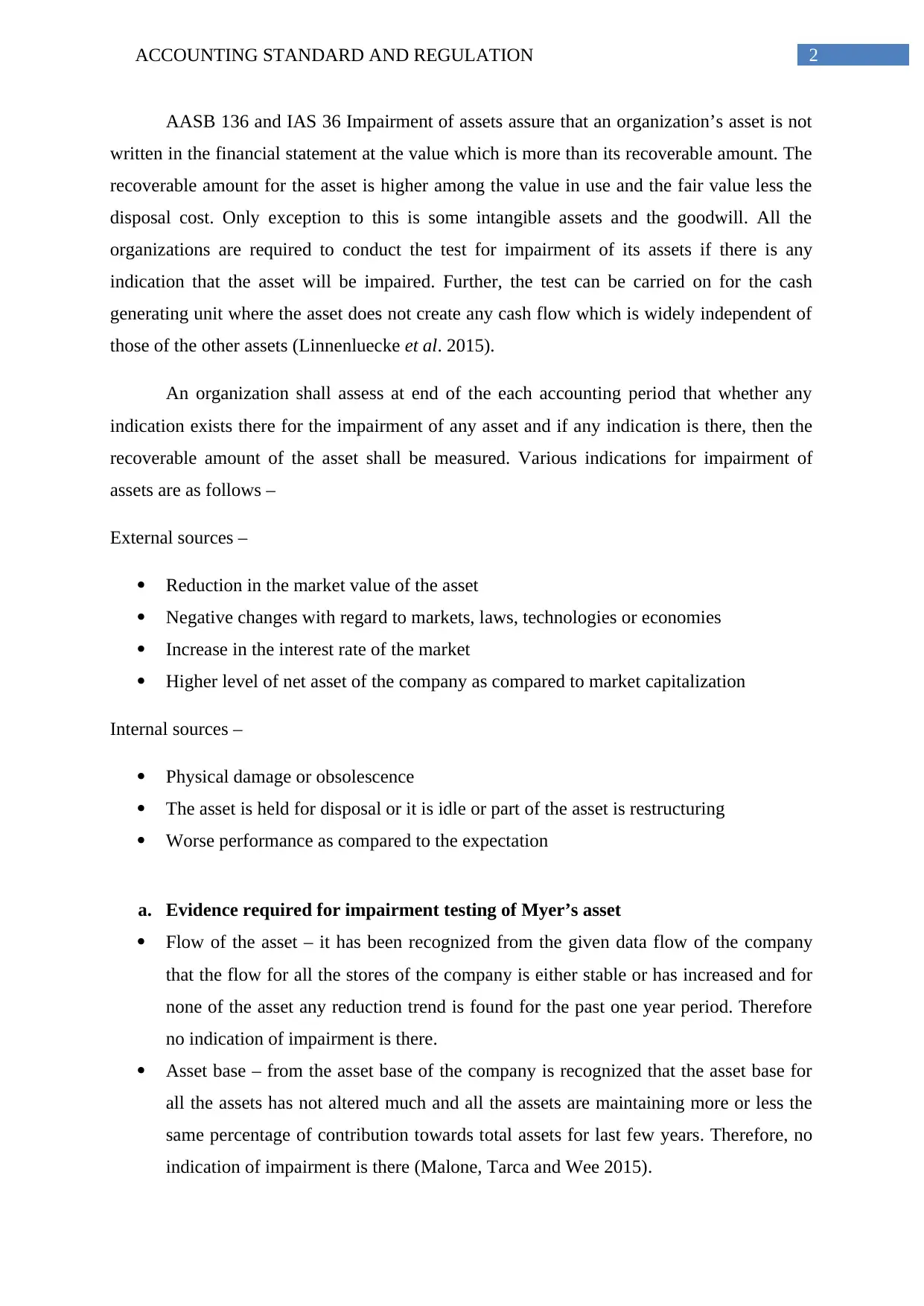
2ACCOUNTING STANDARD AND REGULATION
AASB 136 and IAS 36 Impairment of assets assure that an organization’s asset is not
written in the financial statement at the value which is more than its recoverable amount. The
recoverable amount for the asset is higher among the value in use and the fair value less the
disposal cost. Only exception to this is some intangible assets and the goodwill. All the
organizations are required to conduct the test for impairment of its assets if there is any
indication that the asset will be impaired. Further, the test can be carried on for the cash
generating unit where the asset does not create any cash flow which is widely independent of
those of the other assets (Linnenluecke et al. 2015).
An organization shall assess at end of the each accounting period that whether any
indication exists there for the impairment of any asset and if any indication is there, then the
recoverable amount of the asset shall be measured. Various indications for impairment of
assets are as follows –
External sources –
Reduction in the market value of the asset
Negative changes with regard to markets, laws, technologies or economies
Increase in the interest rate of the market
Higher level of net asset of the company as compared to market capitalization
Internal sources –
Physical damage or obsolescence
The asset is held for disposal or it is idle or part of the asset is restructuring
Worse performance as compared to the expectation
a. Evidence required for impairment testing of Myer’s asset
Flow of the asset – it has been recognized from the given data flow of the company
that the flow for all the stores of the company is either stable or has increased and for
none of the asset any reduction trend is found for the past one year period. Therefore
no indication of impairment is there.
Asset base – from the asset base of the company is recognized that the asset base for
all the assets has not altered much and all the assets are maintaining more or less the
same percentage of contribution towards total assets for last few years. Therefore, no
indication of impairment is there (Malone, Tarca and Wee 2015).
AASB 136 and IAS 36 Impairment of assets assure that an organization’s asset is not
written in the financial statement at the value which is more than its recoverable amount. The
recoverable amount for the asset is higher among the value in use and the fair value less the
disposal cost. Only exception to this is some intangible assets and the goodwill. All the
organizations are required to conduct the test for impairment of its assets if there is any
indication that the asset will be impaired. Further, the test can be carried on for the cash
generating unit where the asset does not create any cash flow which is widely independent of
those of the other assets (Linnenluecke et al. 2015).
An organization shall assess at end of the each accounting period that whether any
indication exists there for the impairment of any asset and if any indication is there, then the
recoverable amount of the asset shall be measured. Various indications for impairment of
assets are as follows –
External sources –
Reduction in the market value of the asset
Negative changes with regard to markets, laws, technologies or economies
Increase in the interest rate of the market
Higher level of net asset of the company as compared to market capitalization
Internal sources –
Physical damage or obsolescence
The asset is held for disposal or it is idle or part of the asset is restructuring
Worse performance as compared to the expectation
a. Evidence required for impairment testing of Myer’s asset
Flow of the asset – it has been recognized from the given data flow of the company
that the flow for all the stores of the company is either stable or has increased and for
none of the asset any reduction trend is found for the past one year period. Therefore
no indication of impairment is there.
Asset base – from the asset base of the company is recognized that the asset base for
all the assets has not altered much and all the assets are maintaining more or less the
same percentage of contribution towards total assets for last few years. Therefore, no
indication of impairment is there (Malone, Tarca and Wee 2015).
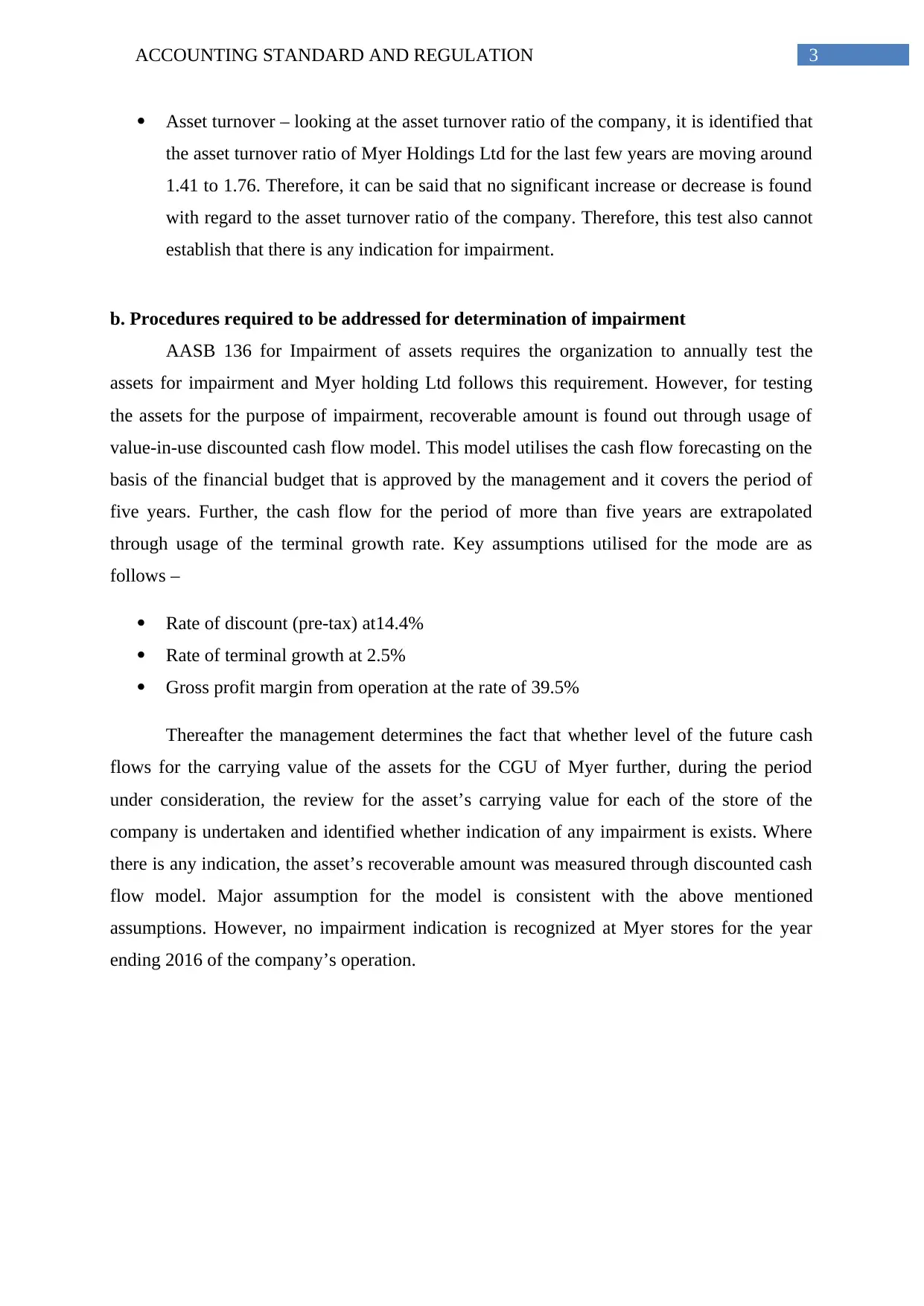
3ACCOUNTING STANDARD AND REGULATION
Asset turnover – looking at the asset turnover ratio of the company, it is identified that
the asset turnover ratio of Myer Holdings Ltd for the last few years are moving around
1.41 to 1.76. Therefore, it can be said that no significant increase or decrease is found
with regard to the asset turnover ratio of the company. Therefore, this test also cannot
establish that there is any indication for impairment.
b. Procedures required to be addressed for determination of impairment
AASB 136 for Impairment of assets requires the organization to annually test the
assets for impairment and Myer holding Ltd follows this requirement. However, for testing
the assets for the purpose of impairment, recoverable amount is found out through usage of
value-in-use discounted cash flow model. This model utilises the cash flow forecasting on the
basis of the financial budget that is approved by the management and it covers the period of
five years. Further, the cash flow for the period of more than five years are extrapolated
through usage of the terminal growth rate. Key assumptions utilised for the mode are as
follows –
Rate of discount (pre-tax) at14.4%
Rate of terminal growth at 2.5%
Gross profit margin from operation at the rate of 39.5%
Thereafter the management determines the fact that whether level of the future cash
flows for the carrying value of the assets for the CGU of Myer further, during the period
under consideration, the review for the asset’s carrying value for each of the store of the
company is undertaken and identified whether indication of any impairment is exists. Where
there is any indication, the asset’s recoverable amount was measured through discounted cash
flow model. Major assumption for the model is consistent with the above mentioned
assumptions. However, no impairment indication is recognized at Myer stores for the year
ending 2016 of the company’s operation.
Asset turnover – looking at the asset turnover ratio of the company, it is identified that
the asset turnover ratio of Myer Holdings Ltd for the last few years are moving around
1.41 to 1.76. Therefore, it can be said that no significant increase or decrease is found
with regard to the asset turnover ratio of the company. Therefore, this test also cannot
establish that there is any indication for impairment.
b. Procedures required to be addressed for determination of impairment
AASB 136 for Impairment of assets requires the organization to annually test the
assets for impairment and Myer holding Ltd follows this requirement. However, for testing
the assets for the purpose of impairment, recoverable amount is found out through usage of
value-in-use discounted cash flow model. This model utilises the cash flow forecasting on the
basis of the financial budget that is approved by the management and it covers the period of
five years. Further, the cash flow for the period of more than five years are extrapolated
through usage of the terminal growth rate. Key assumptions utilised for the mode are as
follows –
Rate of discount (pre-tax) at14.4%
Rate of terminal growth at 2.5%
Gross profit margin from operation at the rate of 39.5%
Thereafter the management determines the fact that whether level of the future cash
flows for the carrying value of the assets for the CGU of Myer further, during the period
under consideration, the review for the asset’s carrying value for each of the store of the
company is undertaken and identified whether indication of any impairment is exists. Where
there is any indication, the asset’s recoverable amount was measured through discounted cash
flow model. Major assumption for the model is consistent with the above mentioned
assumptions. However, no impairment indication is recognized at Myer stores for the year
ending 2016 of the company’s operation.
Secure Best Marks with AI Grader
Need help grading? Try our AI Grader for instant feedback on your assignments.
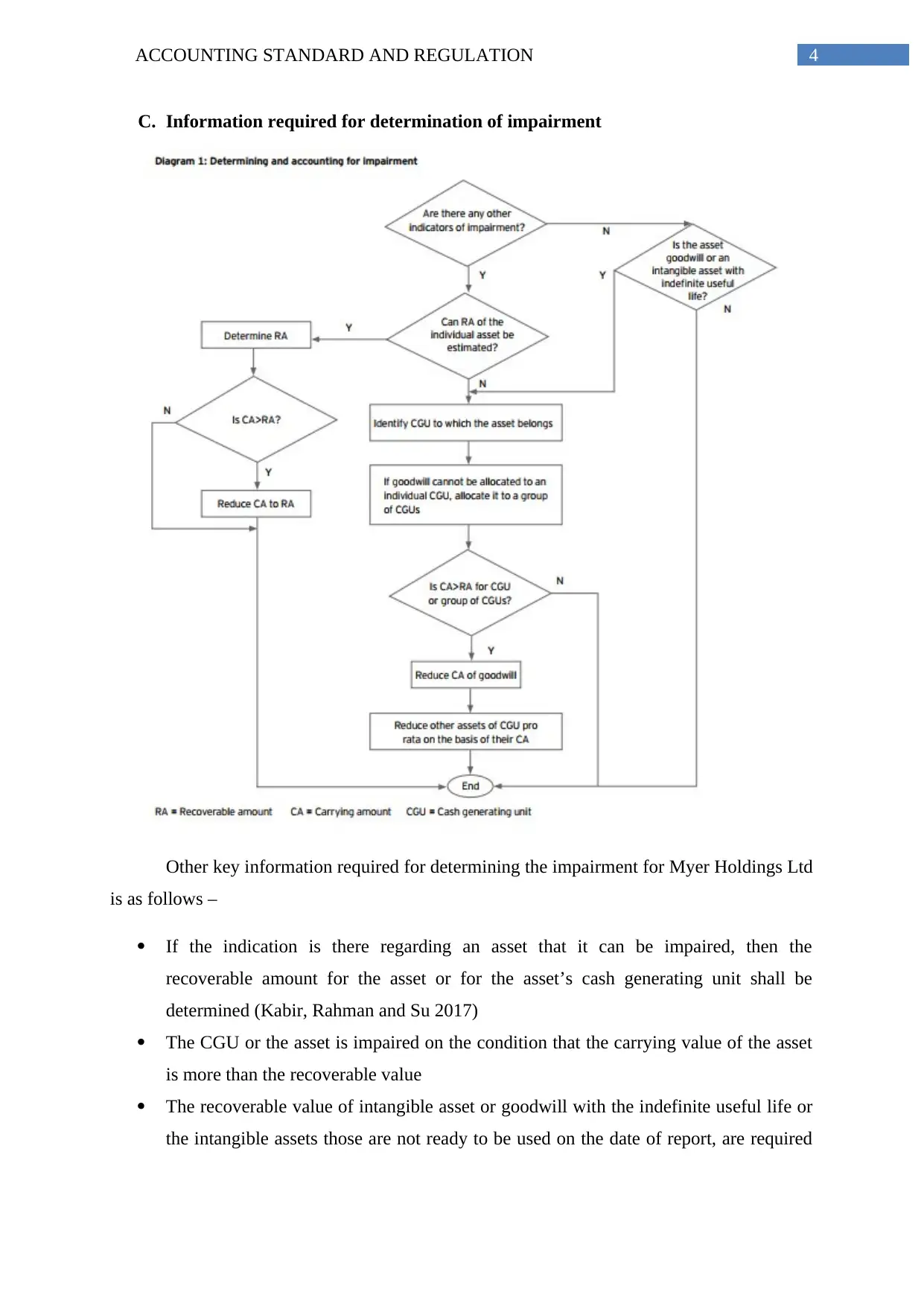
4ACCOUNTING STANDARD AND REGULATION
C. Information required for determination of impairment
Other key information required for determining the impairment for Myer Holdings Ltd
is as follows –
If the indication is there regarding an asset that it can be impaired, then the
recoverable amount for the asset or for the asset’s cash generating unit shall be
determined (Kabir, Rahman and Su 2017)
The CGU or the asset is impaired on the condition that the carrying value of the asset
is more than the recoverable value
The recoverable value of intangible asset or goodwill with the indefinite useful life or
the intangible assets those are not ready to be used on the date of report, are required
C. Information required for determination of impairment
Other key information required for determining the impairment for Myer Holdings Ltd
is as follows –
If the indication is there regarding an asset that it can be impaired, then the
recoverable amount for the asset or for the asset’s cash generating unit shall be
determined (Kabir, Rahman and Su 2017)
The CGU or the asset is impaired on the condition that the carrying value of the asset
is more than the recoverable value
The recoverable value of intangible asset or goodwill with the indefinite useful life or
the intangible assets those are not ready to be used on the date of report, are required
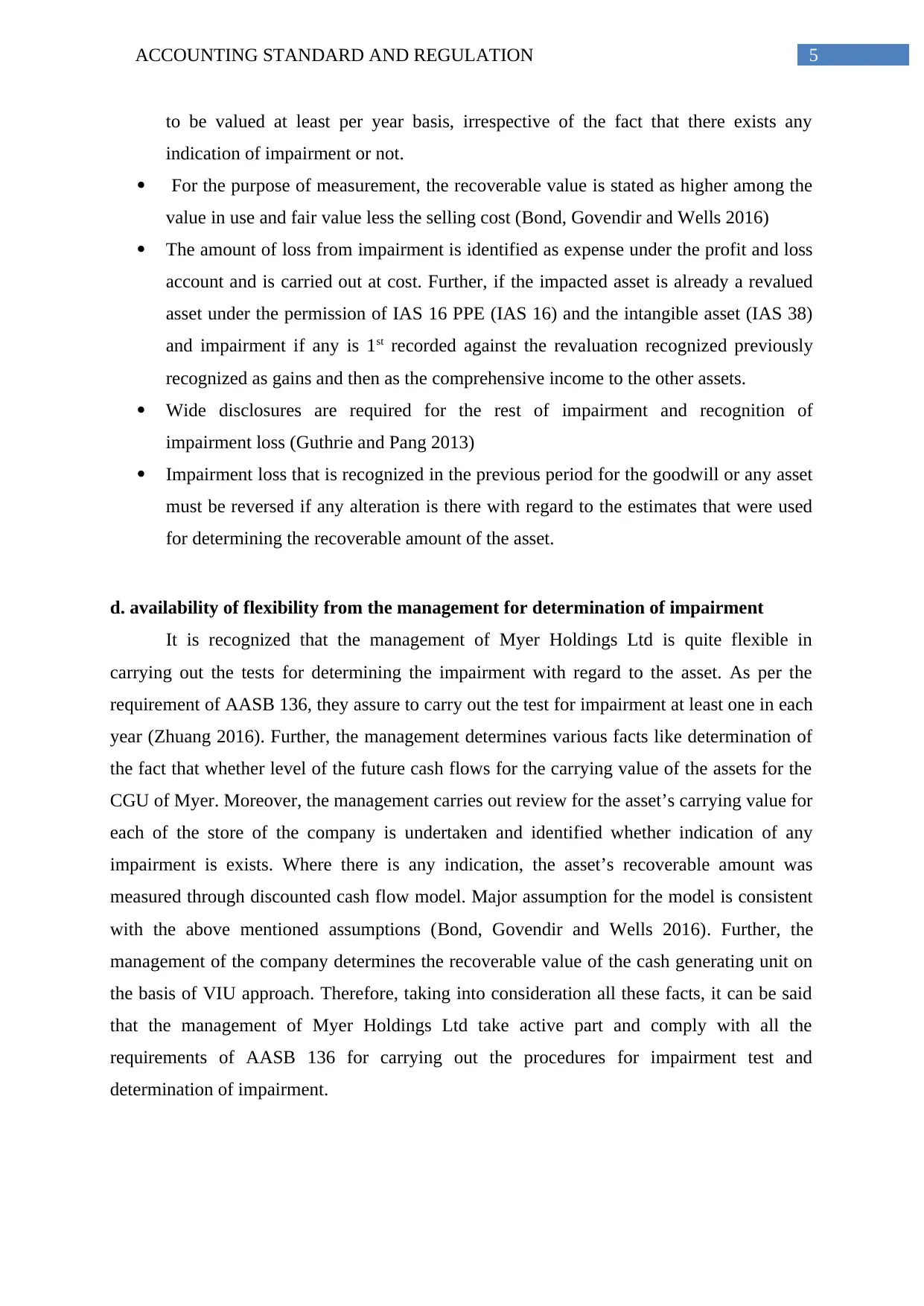
5ACCOUNTING STANDARD AND REGULATION
to be valued at least per year basis, irrespective of the fact that there exists any
indication of impairment or not.
For the purpose of measurement, the recoverable value is stated as higher among the
value in use and fair value less the selling cost (Bond, Govendir and Wells 2016)
The amount of loss from impairment is identified as expense under the profit and loss
account and is carried out at cost. Further, if the impacted asset is already a revalued
asset under the permission of IAS 16 PPE (IAS 16) and the intangible asset (IAS 38)
and impairment if any is 1st recorded against the revaluation recognized previously
recognized as gains and then as the comprehensive income to the other assets.
Wide disclosures are required for the rest of impairment and recognition of
impairment loss (Guthrie and Pang 2013)
Impairment loss that is recognized in the previous period for the goodwill or any asset
must be reversed if any alteration is there with regard to the estimates that were used
for determining the recoverable amount of the asset.
d. availability of flexibility from the management for determination of impairment
It is recognized that the management of Myer Holdings Ltd is quite flexible in
carrying out the tests for determining the impairment with regard to the asset. As per the
requirement of AASB 136, they assure to carry out the test for impairment at least one in each
year (Zhuang 2016). Further, the management determines various facts like determination of
the fact that whether level of the future cash flows for the carrying value of the assets for the
CGU of Myer. Moreover, the management carries out review for the asset’s carrying value for
each of the store of the company is undertaken and identified whether indication of any
impairment is exists. Where there is any indication, the asset’s recoverable amount was
measured through discounted cash flow model. Major assumption for the model is consistent
with the above mentioned assumptions (Bond, Govendir and Wells 2016). Further, the
management of the company determines the recoverable value of the cash generating unit on
the basis of VIU approach. Therefore, taking into consideration all these facts, it can be said
that the management of Myer Holdings Ltd take active part and comply with all the
requirements of AASB 136 for carrying out the procedures for impairment test and
determination of impairment.
to be valued at least per year basis, irrespective of the fact that there exists any
indication of impairment or not.
For the purpose of measurement, the recoverable value is stated as higher among the
value in use and fair value less the selling cost (Bond, Govendir and Wells 2016)
The amount of loss from impairment is identified as expense under the profit and loss
account and is carried out at cost. Further, if the impacted asset is already a revalued
asset under the permission of IAS 16 PPE (IAS 16) and the intangible asset (IAS 38)
and impairment if any is 1st recorded against the revaluation recognized previously
recognized as gains and then as the comprehensive income to the other assets.
Wide disclosures are required for the rest of impairment and recognition of
impairment loss (Guthrie and Pang 2013)
Impairment loss that is recognized in the previous period for the goodwill or any asset
must be reversed if any alteration is there with regard to the estimates that were used
for determining the recoverable amount of the asset.
d. availability of flexibility from the management for determination of impairment
It is recognized that the management of Myer Holdings Ltd is quite flexible in
carrying out the tests for determining the impairment with regard to the asset. As per the
requirement of AASB 136, they assure to carry out the test for impairment at least one in each
year (Zhuang 2016). Further, the management determines various facts like determination of
the fact that whether level of the future cash flows for the carrying value of the assets for the
CGU of Myer. Moreover, the management carries out review for the asset’s carrying value for
each of the store of the company is undertaken and identified whether indication of any
impairment is exists. Where there is any indication, the asset’s recoverable amount was
measured through discounted cash flow model. Major assumption for the model is consistent
with the above mentioned assumptions (Bond, Govendir and Wells 2016). Further, the
management of the company determines the recoverable value of the cash generating unit on
the basis of VIU approach. Therefore, taking into consideration all these facts, it can be said
that the management of Myer Holdings Ltd take active part and comply with all the
requirements of AASB 136 for carrying out the procedures for impairment test and
determination of impairment.
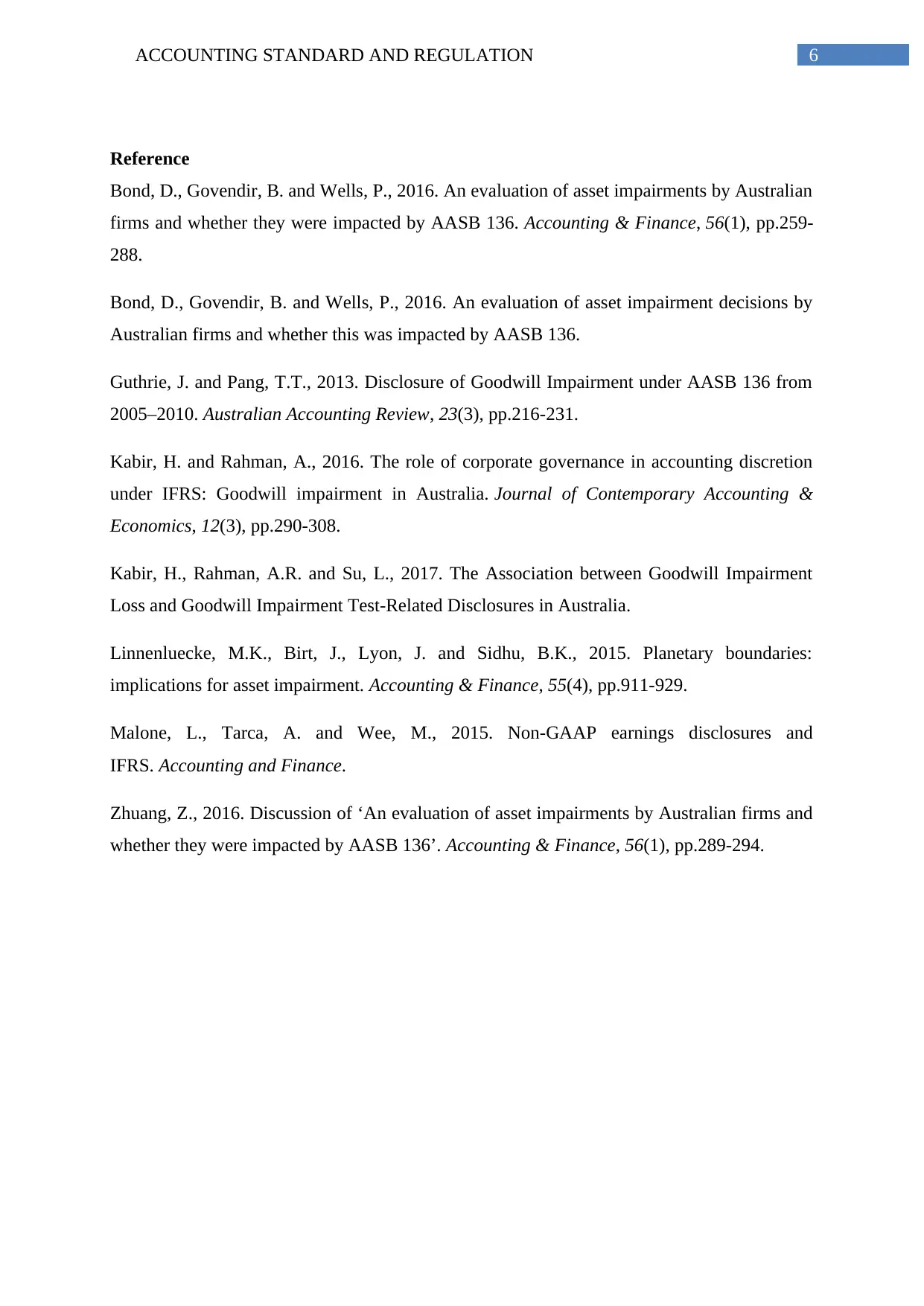
6ACCOUNTING STANDARD AND REGULATION
Reference
Bond, D., Govendir, B. and Wells, P., 2016. An evaluation of asset impairments by Australian
firms and whether they were impacted by AASB 136. Accounting & Finance, 56(1), pp.259-
288.
Bond, D., Govendir, B. and Wells, P., 2016. An evaluation of asset impairment decisions by
Australian firms and whether this was impacted by AASB 136.
Guthrie, J. and Pang, T.T., 2013. Disclosure of Goodwill Impairment under AASB 136 from
2005–2010. Australian Accounting Review, 23(3), pp.216-231.
Kabir, H. and Rahman, A., 2016. The role of corporate governance in accounting discretion
under IFRS: Goodwill impairment in Australia. Journal of Contemporary Accounting &
Economics, 12(3), pp.290-308.
Kabir, H., Rahman, A.R. and Su, L., 2017. The Association between Goodwill Impairment
Loss and Goodwill Impairment Test-Related Disclosures in Australia.
Linnenluecke, M.K., Birt, J., Lyon, J. and Sidhu, B.K., 2015. Planetary boundaries:
implications for asset impairment. Accounting & Finance, 55(4), pp.911-929.
Malone, L., Tarca, A. and Wee, M., 2015. Non-GAAP earnings disclosures and
IFRS. Accounting and Finance.
Zhuang, Z., 2016. Discussion of ‘An evaluation of asset impairments by Australian firms and
whether they were impacted by AASB 136’. Accounting & Finance, 56(1), pp.289-294.
Reference
Bond, D., Govendir, B. and Wells, P., 2016. An evaluation of asset impairments by Australian
firms and whether they were impacted by AASB 136. Accounting & Finance, 56(1), pp.259-
288.
Bond, D., Govendir, B. and Wells, P., 2016. An evaluation of asset impairment decisions by
Australian firms and whether this was impacted by AASB 136.
Guthrie, J. and Pang, T.T., 2013. Disclosure of Goodwill Impairment under AASB 136 from
2005–2010. Australian Accounting Review, 23(3), pp.216-231.
Kabir, H. and Rahman, A., 2016. The role of corporate governance in accounting discretion
under IFRS: Goodwill impairment in Australia. Journal of Contemporary Accounting &
Economics, 12(3), pp.290-308.
Kabir, H., Rahman, A.R. and Su, L., 2017. The Association between Goodwill Impairment
Loss and Goodwill Impairment Test-Related Disclosures in Australia.
Linnenluecke, M.K., Birt, J., Lyon, J. and Sidhu, B.K., 2015. Planetary boundaries:
implications for asset impairment. Accounting & Finance, 55(4), pp.911-929.
Malone, L., Tarca, A. and Wee, M., 2015. Non-GAAP earnings disclosures and
IFRS. Accounting and Finance.
Zhuang, Z., 2016. Discussion of ‘An evaluation of asset impairments by Australian firms and
whether they were impacted by AASB 136’. Accounting & Finance, 56(1), pp.289-294.
1 out of 7
Related Documents
Your All-in-One AI-Powered Toolkit for Academic Success.
+13062052269
info@desklib.com
Available 24*7 on WhatsApp / Email
![[object Object]](/_next/static/media/star-bottom.7253800d.svg)
Unlock your academic potential
© 2024 | Zucol Services PVT LTD | All rights reserved.





